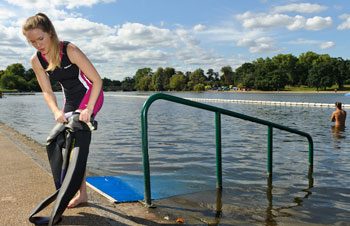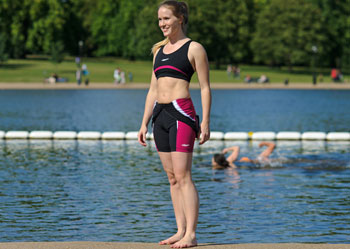Thinking of Trying a Tri?
So, you’re considering a triathlon. What’s next? What is triathlon, how do you sign up, how do you train, and most importantly, can you do it? Yes you can! Our beginner’s guide to triathlon will help you get started!
Triathlon is made up of swimming, biking, and running, typically done in succession, in that order. There are some races that mix the order up or involve kayaking instead of swimming, but these are less traditional.
Many people know of triathlon because of the world-famous Ironman, an endurance race featuring a 2.4-mile (3.86 km) swim, a 112-mile (180 km) bike, and a 26.2-mile (42.2 k) run – yes, a full marathon, all in one go. Triathlon has spread around the world, with thousands clamouring to complete the Iron-distance, but many participating in much shorter races. In fact, the Olympic distance is a more manageable 0.9 mile swim, 25-mile bike, and 6.2-mile run. There are sprint races and super-sprint that are much shorter and can be completed by most in less than two hours… meaning there is a triathlon for almost everyone!
So how do you find a tri?
Triathlon is everywhere, but finding the right race for you can be difficult when you’re new. One easy way is to check out the British Triathlon Event Finder. You just type in your postcode and are led to races in your area. It’s a good idea to start with a sprint distance race and work your way up to longer distances so that your body has time to build up strength and endurance – without the likelihood of injury. And finishing your first race is a great confidence builder. This confidence will likely fuel your drive to continue in the sport and to perhaps move on to a longer distance!
Another great option are women’s only triathlons. There are plenty of races just for us girls that offer a supportive, fun environment minus the testosterone-fuelled competition that sometimes dominates racing with the boys.
An alternative way to choose a race – and to start training – is to join a club. Triathlon clubs typically have several group training sessions a week to help keep you motivated, as well as tons of information regarding recommended races in your area. Plus you’ll be surrounded by like-minded individuals (and believe it or not, triathletes tend to work hard AND play hard, so they’re a pretty fun group!)
The British Triathlon website lists clubs by region, so it’s easy to find one near you.
 What about training?
What about training?
Joining a club (or even paying for a coaching group) is also a great way to learn more about training and to get fit with a group. If you’d really prefer going it alone (or just want to give tri a try before spending money on training), there are lots of free or inexpensive training plans online. We recommend Beginner Triathlete for a wealth of training advice and a good range of plans, or Trinewbies for a similar plethora of knowledge!
One thing a lot of training plans don’t mention is training for your transitions – these are the crucial moments between the three sports (in other words, when you transition from swim to bike or bike to run). Even if you’re not going for a record-breaking time, knowing what you’re doing in the “transition area” is key, so practice setting up your area. It’s important that you know where everything is, have everything visible so that you can see it for easy and quick changes, and that you don’t forget important things you need. We can’t tell you how embarrassing it is to start the run in your cycle helmet (or how sad you are when you get out on the bike and realize that you forgot your sunglasses or left your sports drink behind). Actually, we can tell you, because we’ve done both. Practice transitions!!
Equipment?
We are not going to lie to you – triathlon can get expensive. Race fees seem to have gone through the roof along with the popularity of triathlon, but there’s also a lot of equipment. Unless money is just burning a whole in your pocket, we’d recommend purchasing equipment as you go along. No matter what, you need some basics (swim goggles, bike and helmet, running shoes), but there is no need to splash out. Sign up for races that welcome beginners (trust us there are a lot!) and ride the bike that you already have.
Get by with the minimum and reward yourself for finishing the race with something new, be it your first triathlon-specific top (we recommend Trigirl!), a good wetsuit or some aerobars (aerobar tip – practice using them in training!). No need to spend loads of money and then decide the sport just isn’t for you!
Check out our article on Top 10-Triathlon Essentials.
Nothing New On Race Day
Another great equipment tip we’ve picked up along the way? Nothing new on race day! That means train with everything you plan to wear, plan to eat, plan to use in any way. There’s nothing like socks that cause blisters (but you didn’t know because – ouch! – they’re new) or food that upsets your stomach (but you didn’t know because you trained solely on water) or even worse, to realize that you don’t know how to use your fancy new pedals or that your new goggles leak… Practice everything before the race including the kit that you intend to wear to avoid surprises!
 Race Day
Race Day
Before the race even starts, know the course! It’s easiest to swim in the right direction when you know what that direction is. Hills on the bike won’t seem as daunting when you know where to expect them and you’ve trained for them. Pacing yourself will be easier when you have a good idea how far you have left to go. Most race websites provide good course descriptions, maps, and even turn-by-turn directions. You can sometimes also find race reports online from past participants.
We are giving you a helping hand with our Trigirl Race Day Checklist.
The swim
Try to get a good estimate during your training about your comfort-levels in the swim. The triathlon start can be a disorienting and even frightening moment when the gun goes off and a huge group of arms and legs start swimming all at once. Position yourself according to comfort level and speed (if you’re uncomfortable and not-so-speedy, don’t get in the very front and centre of the crowd!) In fact, for your first race, it’s a good idea to keep out of the centre of the pack regardless. Keep calm and don’t go out too fast – it’s exciting, but you’ve got a long way to go!
The bike
After a well-practised transition, you’re on the bike – what now? Settle in. Take some sips from your water bottle and get yourself oriented. Sometimes it feels a little weird to start riding after spending time in the water. Get your legs moving in a low gear (the gears where your legs can move quickly and easily vs. pushing hard in a high gear) and then do what you’ve trained for – ride your bike. Again, remember, this is about combining three sports together, so while it’s fun to go fast, save something for the run!
The run
Finally, this is what all of that training has been for. You’ve left your helmet in transition, pulled on your running shoes, and you’re off on the run. Depending on race distance, some pacing is perhaps still required, but this is where your brick workouts really come in to play. That strange feeling in your legs is expected and you know just about when you can expect it to go away. Have fun, work hard, and picture that finish line. You’re almost there, and you’re going to make it!


